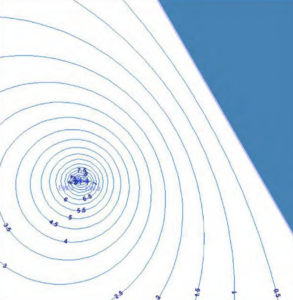Challenge
To assess an aquifer system and its capacity to serve as a long-term, sustainable water supply for the next 20 to 50 years at a Site located in western Indiana along the Wabash River. An industrial facility planned to develop a new steam generating plant for its facilities adjacent to the Wabash River. The proposed plan included the installation of three (3) new wells each with a capacity rating of 450 gallons per minute (gpm) in addition to the existing three (3) wells operating with an average pumping rate of 575 gpm. The client wanted to ensure that the installation of the new wells would not adversely affect the existing well capacity and that the groundwater quality and quantity would provide a long-term sustainable source for the steam operations.
Action
Mundell reviewed published geological, hydrogeological, and nearby property use to characterize the aquifer system in the area. In addition, Mundell analyzed Site-specific geologic data (e.g., pump test and soil boring grain size data) to better estimate the Site specific aquifer permeability (i.e., hydraulic conductivity). Using this data and information, Mundell developed a Site-specific Conceptual Site Model to initiate a numerical groundwater model (using the well known United States Geological Survey computer code MODFLOW). Given Site complexities and limitations in the available data, Mundell also used a second class of model (i.e., a transient analytical model) to confirm the aquifer parameters at the Site and validate the model performance. In addition, Mundell conducted a sensitivity analysis to better understand the uncertainties in the data and factors that may affect the modeling results. Lastly, Mundell evaluated historical precipitation and Wabash River stream gage data to determine the normal and drought conditions that might occur at the Site. Using the results of the drought assessment, Mundell used its groundwater model to assess the impact that future drought and adverse climate conditions may have on the aquifer’s ability to serve as a long term water supply for the Site.
Results
Mundell successfully analyzed the Site-specific geologic data and created a Site-specific MODFLOW model. The model was successfully calibrated and validated using various techniques, and the model was used to evaluate several scenarios. The assessment revealed that the aquifer will most likely have the capacity to sustainably meet the proposed pumping conditions under normal and drought conditions for the next 20 to 50 years. However, some of the data indicated that there may be localized, less permeable zones at the Site which may affect the aquifer’s capacity. As such, Mundell recommended further aquifer testing once the new wells were installed to confirm the aquifer parameter estimates and aquifer’s response to pumping at the Site. Lastly, in addition to the modeling efforts, Mundell’s review of the nearby and historical property usage did not reveal any evidence of current or past groundwater contamination that might limit the proposed use of groundwater at the Site.



